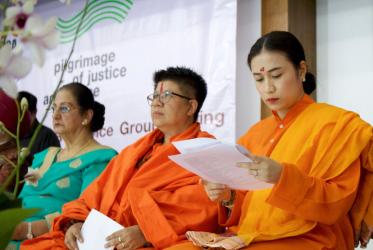1. Texts
Creation is a basic theme of the Bible. In fact the Bible begins with the story of creation. Many of the Psalms celebrate the theme. Creation is also a basic assumption in the New Testament which ends with a vision of a new creation.
Creation, however, is also a basic theme in many other religious traditions. Here are some examples:
a) From the Shinto thought:
The grains that grow, The myriad trees and grasses - All are blessings Of the Great Kami of the Sun Who lightens the Heaven.
But for the blessings
of the Kami
Of Heaven and earth,
could we live
One day, one night?The food that sustains life,
our clothes, our dwelling --
They are the blessings
of our Ruler
of our Kami.
Motoori NorinagaTsunetsugu Muraoka, Studies in Shinto Thought, Japanese National Commission for UNESCO, 1964, p. l57.
b) The following text from the ancient and influential Chinese classic, the Tao Te Ching, emphasizes the universal principle, Tao, the Way, that undergirds all created order:
There was something formless yet complete, That existed before heaven and earth; Without sound, without substance, Dependent on nothing, unchanging, All-pervading, unfailing. One may think of it as the mother of all things under heaven. Its true name we do not know; "Way" is the by-name that we give it. Were I forced to say to what class of things it belongs I should call it Great.
Tao Te Ching XXV, from Arthur Waley, The Way and its Power, New York, Grove Press, 1958.
c) From the Pacific Islands of Polynesia, there is this story of creation by God, called Ta'aroa:
He existed, Ta'aroa was his name. In the immensity (space) There was no sea, there was no man. Above, Ta'aroa calls. Existing alone, he became the universe. Ta'aroa is the origin, the rocks. Ta'aroa is the sands. It is thus that he is named. Ta'aroa is the light; Ta'aroa is within; Ta'aroa is the germ. Ta'aroa is beneath; Ta'aroa is firm, Ta'aroa is wise. He created the land of Hawaii, Hawaii the great and sacred, As a body or shell for Ta'aroa....
E.S. Craighhill Handy, Polynesian Religion, Bernice P. Bishop Museum Bulletin 34, Honolulu, Bishop Museum Press, 1927. Reproduced in Charles Long, Alpha: the Myths of Creation, New York, Braziller, 1963.
d) The understanding of creation is also revealed in prayers to the Creator, as in this modern Zoroastrian prayer:
Thou, dear Ahura Mazda, art the Master Planner, the Lord of all Creation; the Essence of Boundless Time and the very Spirit of Truth and Goodness. Thou art All-Wise and All-Knowing. Not a leaf falls but Thou knowest it. Thou tellest the number of trees and the leaves upon them. Thou knowest the number of particles of sand on any seashore and the number of stars overhead. Thou knewest me better than I knew myself.
Quoted in "Learning from Other Faiths", George Appleton, Third Lambeth Interfaith Lecture, 1981, p. 2.
e) This Hindu text is from the Svetasvatara Upanishad which, according to many interpreters, celebrates the Personal God as Ultimate Reality:
The One who rules over every single source, In whom this whole world comes together and dissolves. The Lord, the blessing-giver, God adorable By revering Him one goes for ever to His peace.
More minute than the minute, in the midst of confusion The Creator of all, of manifold forms, The One embracer of the universe By knowing Him as kindly one attains peace forever.
By knowing as kindly Him who is hidden in all things, Exceedingly fine, like the cream that is finer than butter, The One embracer of the universe By knowing God one is released from all fetters.
His form is not to be beheld. No one-soever sees Him with the eye, They who thus knew Him with heart and mind As abiding in the heart, become immortal.
From R.E. Hume, The Thirteen Principal Upanishads, London, Oxford, University Press, 1971, pp. 404-405.
2. Comment
The creation stories in different religious traditions have a variety of functions in their total belief systems. In the Shinto text there is emphasis on creation (nature) as the expression of the benevolent presence of the divine with the whole of nature. In the Taoist text, on the other hand, the focus is on the principle (Tao) that governs all life calling on the whole of creation, including humanity, to be in a harmonious relationship. In the Polynesian account of creation, Ta'aroa seems to create the universe out of his very self. The Svetasvatara Upanishad tells of a Creator who is at once supreme and the very essence of all things. He is not only a principle or reality, but a kindly God, whom one can adore and worship.
3. Discussion and questions
Study the biblical stories of creation found in Genesis 1 and 2, perhaps looking also at a hymn to the Creator, such as that found in Psalm 104.
Discuss your own understandings of creation, with the input and insights drawn from these and similar accounts of creation in other traditions This might be a session to which you may want to invite a person: or persons of other faiths to discuss with them their understanding of creation.
a) What is a story of creation? Why do people tell stories of creation? What do you think is the purpose of such stories? How do such stories or accounts shape our attitudes towards one another as human beings, and towards the world of nature?
b) What does it mean to understand God as the parent of humankind as a whole? What does this suggest for our relations with and attitudes towards people of other faiths?
c) What do the various accounts of creation, including our own, tell us of the natural world and humanity's relation to nature? Do these views help us to understand better and deal more effectively with the ecological crisis?&nb


